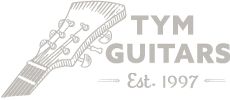1968 Teisco May Queen
Share
In the plethora of bizarre vintage Japanese guitars few stand out as beautifully iconic as the Teisco May Queen. I've written about the May Queen before, along with its close siblings the Fire Bird and Vamper but my love of these is endless and lately I have been thinking that I really need to make a TMI version so satisfy a nagging feeling I've had for many years.

The May Queen was introduced in 1967 soon after the Kawai takeover of Teisco and the wonderful shapes of many in this series was probably an attempt to sell non-American shaped instruments to a young and adventurous market as guitar sales started to wane in the late 60's.

The new Kawai company wanted some interesting and radical shapes to invigorate a young market and used its newly acquired Teisco as a way of marketing some of these exciting ideas.


The May Queen is a wonderful amalgam of bizarre Japanese, Rickenbacker, EKO (Eko Auriga) and Vox all rolled into one beautifully executed design which is surprisingly comfortable to play both standing and seated. It's unclear who used this shape for a full-sized guitar first, but it is almost definitely heavily inspired by the Vox Mando-Guitar which was designed in 1964 and later manufactured by EKO in Italy. The Eko Auriga appeared in 1968 with a similar body shape to the May Queen but being a solid body. While the Teisco May Queen was made by Kawai at their Enshu factory after the takeover, similar bodies were made by the previous manufacturer Teisco-Gen-Gakki for brands like Apollo which also appeared in 1968.

The body is hollow plywood as was the rage in late 60's Japanese guitar manufacturing. A couple of years earlier some limits had been applied to the manufacture of solid body electric guitars and most of the big factories and brands pushed heavily into the hollowbody electric market. This method of construction would prove not only economical, but efficient with most of the big factories pressing out a multitude of shapes using the same construction.


The neck is a standard bolt on style and is comfortable and well made with a good finish and nice fretwork. The rosewood fretboard has 22 medium small frets and a zero fret with plastic string guide like all Teiscos of this period. The tuners are standard pressed sealed gear tuners that adorned a million guitars over the years.


The pickups in these original May Queens were a double blade style single coil and have a great clarity with good punch. Not unlike a Ric high gain in tone which is also made more noticeable by the hollow body construction. Controls are simple with a 3-way selector switch with master volume and tone controls.

These are well made mid-level Teiscos with the original May Queen being 22.500 JY in '68 well below the Fire Bird (32.000 JY) and the Vegas 66 (39.000 JY) in the lineup. The Vamper EV-52T was a massive 52.000 JY at the time making it over twice the price of the May Queen.

In the very late 1990's Kawai re-issued the May Queen along with the K series, TG-50 and Spectrum guitars and basses which sold quite well. I've written about these re-issues several times and as I've said before, I've owned many originals and re-issues and the re-issues are every bit as good, better in some cases than the originals which now online dealers seem to be asking exorbitant amounts of money for? With the May Queen being easily the most sold model in this '67/68 Teisco series and the re-issues being fairly plentiful and better playing guitars it seems odd that these "rare" vintage Japanese models now seem to command such high (asking) prices.

Don't get me wrong. I LOVE (I mean LOVE) these guitars, but they seem be getting artificially inflated in price and rarity (often with vastly varying degrees of misinformation and sales talk) by online dealers trying to cash in on cheap cool.
